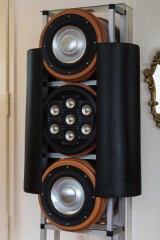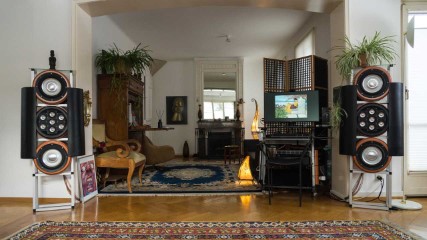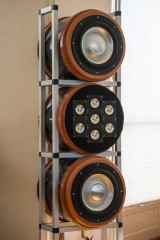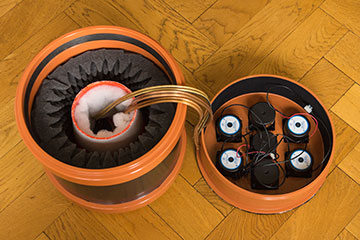The Magical Number Seven, Plus Two
This DIY loudspeaker system experiments with multiple small wide-range transducers in a multiway configuration. The idea is to join good directional characteristics to coherence and power handling. Another goal is to improve timing by controlling the phase with FIR filters. This is an upgrade to my 2018 system with new filtering and the addition of "cheeks" to the speaker columns.
Wide range
The main speakers are based on seven E.J.Jordan JXR6 HD that I picked up from a previous linear array system. Arranged as close together as possible, they form three groups having the same acoustic center:
- The driver in the middle of the baffle has an effective diameter of 5.6 cm. It is used as a tweeter.
- The up and down ones, wired in series, equivalent to a single 7.9 cm, are for the midrange.
- The four side drivers, two series wired in parallel, thus doubling the sound pressure, equivalent to a single 11.2 cm, take the low frequencies.
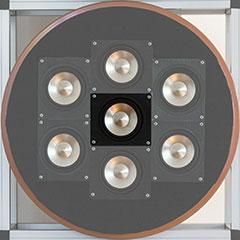
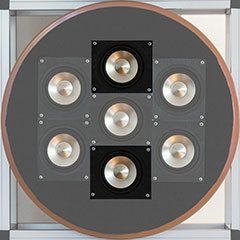
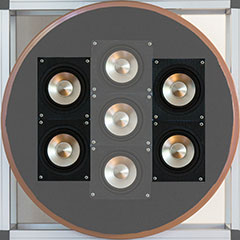
The 20 liter sealed enclosures are made of 30 cm PVC pipes filled with polyurethane foam and a polyester fleece. A tapered internal partition helps reduce the standing waves that start around 600 Hz. The build is simple: just a PVC KGU-socket connecting sleeve (which has rubber rings) and two KGM plugs (no glue). The baffle is covered with a 5 mm felt sheet to reduce diffraction and make the drivers flush.
The graphs below show the magnitude response and group delay
measured with a log sweep from 16 to 24000 Hz taking 21.8 s.
The magnitude response stays inside ±3 dB from 200 to 20000 Hz.
Group delay rise below 250 Hz reflects the low frequencies roll-off.
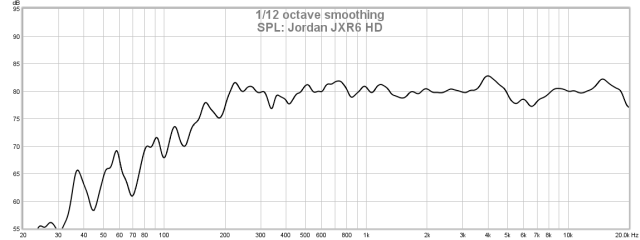
Average measure of the six groups of small drivers at 50 cm.

Group delay (blue), minimum group delay (gray), and excess group delay (black).
Subwoofers
The bass extension is provided by two 20 cm
SB Acoustics
SW26DAC76-4
per channel.
With dual rigid aluminum cone and moderate moving mass,
these lightweight (neodymium magnet) drivers can be used in rather small sealed enclosures.
The 21 liter enclosures were very easy to build: PVC connecting sleeve and two plugs.
They are arranged up and down the main speakers in a way that the acoustic centers match.
Calculated Qtc=0.86 and F3=35 Hz.
Internal standing waves start around 600 Hz, well away from the intended operating range.
The magnitude response is very smooth from 40 to 500 Hz.

Average measure of the four subwoofers at 5 cm. 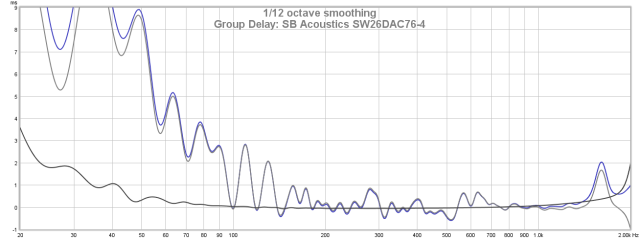
Group delay (blue), minimum group delay (gray), and excess group delay (black). |

|
Operating
Digital to analog conversion tasks an 8-channel
miniDSP
U-DAC8
at its best with
iFi Audio
iPower
and
iGalvanic3.0.
A Behringer
Ultralink Pro MX882 V2
splits the stereo signal into the dual subwoofers.
Power is supplied by two
Rotel
RMB-1565
5-channel Class D amplifiers, one for each stereo channel.
Instead of a dedicated DSP, the computer does all the filtering, equalization and phase linearization.
I believe it's a better solution because the PC has all the power to compute the FIR filters
for phase control. Replacing hardware DSP by computer software is just smarter
and can be a lot more economical.
This tutorial may help configuring the PC:
Windows PC as a FIR Audio Processor.
The computer is configured with Jonas Thedering's Equalizer APO. The E-APO configuration file looks like this:
Device: USBStreamer - USBStreamer Multi-channels
Eval: mainLevel=0
# Channels (7.1)
# 1 2 3 4 5 6 7 8
# L R C LFE RL RR SL SR
# 3.1 source
# Copy: 1=L+0.5*LFE 2=R+0.5*LFE 3=L+0.5*C 4=R+0.5*C 5=L+0.5*C 6=R+0.5*C 7=L+0.5*C 8=R+0.5*C
# Stereo source
Copy: 1=L 2=R 3=L 4=R 5=L 6=R 7=L 8=R
# Equal-loudness
LoudnessCorrection: State 0 ReferenceLevel -20 ReferenceOffset 0 Attenuation 0.25
# Convolution
Channel: 1 2
Convolution: IR_sub.wav
Channel: 3 4
Convolution: IR_low.wav
Channel: 5 6
Convolution: IR_mid.wav
Channel: 7 8
Convolution: IR_high.wav
# Levels
Channel: 1 2
Preamp: `mainLevel-0.5` dB
Channel: 3 4
Preamp: `mainLevel-12` dB
Channel: 5 6 7 8
Preamp: `mainLevel-6` dB
To generate the finite impulse response stereo WAV files I use Thomas Drugeon's rePhase loudspeaker phase linearization, EQ and filtering tool. With the following impulse settings, precision is 1.46 Hz up to 48 kHz. Including 10 ms for APO processing, total latency is 331 ms.
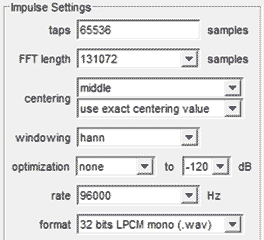
Crossover
I applied Horbach-Keele filters according to their 2007 paper:
Application of Digital Crossover Filters to Pair-Wise Symmetric Multi-Way Loudspeakers.
The zero-phase crossover frequency responses that result from this design method require the use of DSP techniques for implementation.
What is unique about this crossover technique is that at any specific frequency, only a single way or two ways are operating simultaneously.
Given here their separation of 70 cm, the subwoofers become directional from 165 Hz.
With critical frequencies at the musical notes la A1-A3-A5, spacing ratios are 4. The crossover frequencies are 158, 632 and 2654 Hz.
The wavelength of the critical frequency of the midrange (1760 Hz) provides a vertical beamwidth of about 50°.
I am aware that this particular arrangement of speakers doesn't completely adhere to the rules. Yet Horbach-Keele filters give more consistent results than any others I have tried.


Average measures at 50 cm, 1/12 octave smoothing.
Equalization
Low frequencies phase and magnitude responses are linearized by inverted second order filters (rePhase compensate mode).
Steeply sloped shelf filters reduce the highs by 2 dB at the H-K critical frequencies 440 and 1760 Hz and raise them at 5274 Hz.
The following figures show the equalizations with (red) and without (blue) low/high-pass filters.
You may copy the settings to clipboard and load them in rePhase.
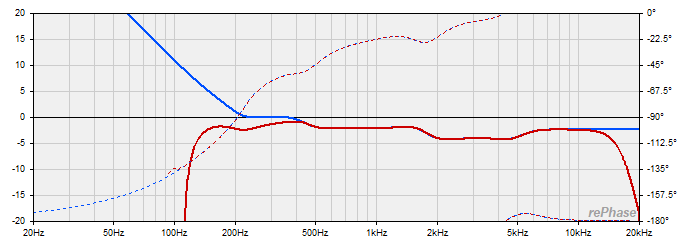
rePhase settings for
low,
midrange and
high frequencies.
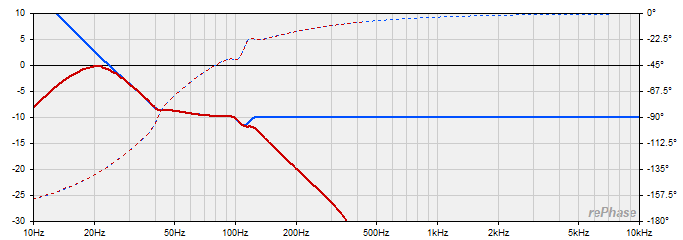
rePhase settings for
subwoofers.
Results
For the measures, I used John Mulcahy's
REW
analysis software.
After equalization, the phase responses are aligned and the magnitude response extends from 25 to 16000 Hz.

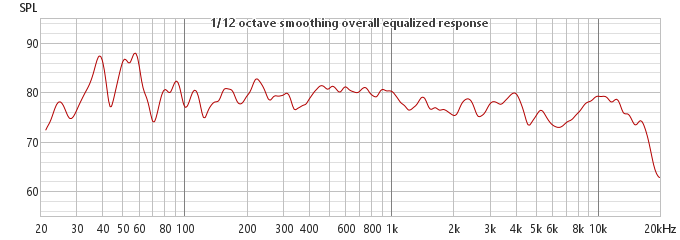
Average measures of the left and right loudspeakers at 50 cm.
Conclusion
The light aluminium transducers produce a clear and detailed sound that engages attention.
Using them in such a configuration is obviously beneficial to the homogenity of the sound reproduction,
so the promise of full spectrum coherence is clearly delivered.
Thanks to balanced directivity, the sonic colour remains consistent over a wide listening field.
This always feels natural, whether the music is relaxing or energizing. I've had this system for five years and its latest update has given me even more satisfaction.
What about the shortcomings? In theory, the cylindrical enclosures are a weakness and specifically designed baffles might be an improvement.
This doesn't negate the benefits of the 7+2 drivers configuration and
I would advise the curious hobbyist to give it a try.
2018 - 2023
 JdM12
JdM12